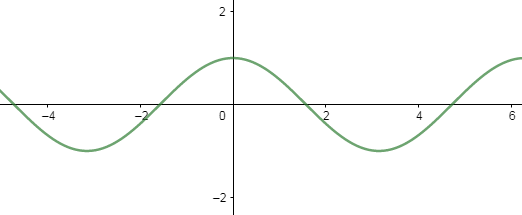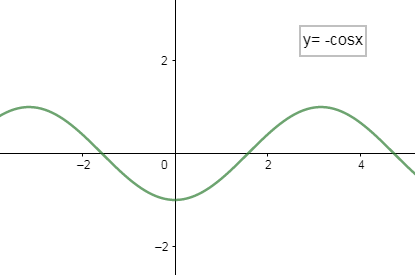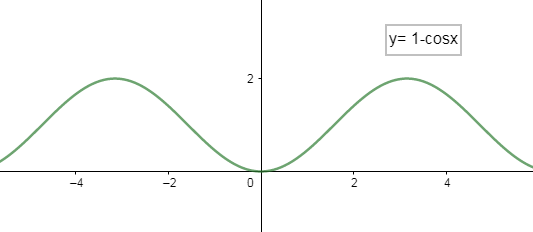
How do you graph $y=1-\cos x$ ?
Answer
545.1k+ views
Hint: In this question, we have to plot the graph of an equation. The equation given to us consists of trigonometric functions. So, we will first draw the graph of the parent function cosx, which is $y=\cos x$ and then we will draw the graph of $y=-\cos x$ as given in the question. After that, we see that both the parent function graph and $y=-\cos x$ , will have the same range. Then we will add 1 on the right-hand side of the equation and make the necessary changes in the new graph, that is we see that the new graph will shift upwards and lie above the x-axis, which is the required solution to the problem.
Complete answer:
According to the question, we have to plot a graph of a trigonometric equation.
The equation given to us is $y=1-\cos x$
So, first, we will draw the graph of the parent function, that is
$\Rightarrow y=\cos x$ ----------- (1)
As we know the domain of cosx function is real numbers, and its range is $-1\le cosx\le 1$ , therefore the graph of the equation (1) is

Now, we will draw the graph of $y=-\cos x$ , because it is given in the question, we get

Thus, we see the graph of $y=-\cos x$ , reflect over the x-axis
Now, we will add 1 on the right-hand side of the equation (1), which means we are shifting our graph up by 1 unit, therefore, we get

Therefore, we see in the above graph that as we add 1, the actual graph of $y=-\cos x$ shifts upward and lies above the x-axis.
The range of the new equation, that is $y=1-\cos x$ , is [0, 2].
Note: While drawing the graph in this question, do mention all the equations you are plotting. Keep in mind that 1 is adding in the equation $y=-\cos x$ and that is why the graph shifts upward and not below the x-axis.
Complete answer:
According to the question, we have to plot a graph of a trigonometric equation.
The equation given to us is $y=1-\cos x$
So, first, we will draw the graph of the parent function, that is
$\Rightarrow y=\cos x$ ----------- (1)
As we know the domain of cosx function is real numbers, and its range is $-1\le cosx\le 1$ , therefore the graph of the equation (1) is

Now, we will draw the graph of $y=-\cos x$ , because it is given in the question, we get

Thus, we see the graph of $y=-\cos x$ , reflect over the x-axis
Now, we will add 1 on the right-hand side of the equation (1), which means we are shifting our graph up by 1 unit, therefore, we get

Therefore, we see in the above graph that as we add 1, the actual graph of $y=-\cos x$ shifts upward and lies above the x-axis.
The range of the new equation, that is $y=1-\cos x$ , is [0, 2].
Note: While drawing the graph in this question, do mention all the equations you are plotting. Keep in mind that 1 is adding in the equation $y=-\cos x$ and that is why the graph shifts upward and not below the x-axis.
Recently Updated Pages
Why are manures considered better than fertilizers class 11 biology CBSE

Find the coordinates of the midpoint of the line segment class 11 maths CBSE

Distinguish between static friction limiting friction class 11 physics CBSE

The Chairman of the constituent Assembly was A Jawaharlal class 11 social science CBSE

The first National Commission on Labour NCL submitted class 11 social science CBSE

Number of all subshell of n + l 7 is A 4 B 5 C 6 D class 11 chemistry CBSE

Trending doubts
What is meant by exothermic and endothermic reactions class 11 chemistry CBSE

10 examples of friction in our daily life

One Metric ton is equal to kg A 10000 B 1000 C 100 class 11 physics CBSE

1 Quintal is equal to a 110 kg b 10 kg c 100kg d 1000 class 11 physics CBSE

Difference Between Prokaryotic Cells and Eukaryotic Cells

What are Quantum numbers Explain the quantum number class 11 chemistry CBSE




